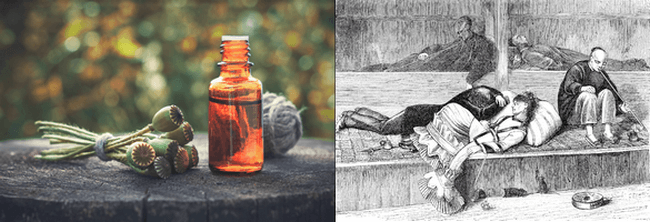VICTORIAN ENGLAND COMES TO TERMS WITH A NATIONAL HABIT


Author: Liese Sherwood-Fabre, award-winning writer

WARNING: Drug use is dangerous for your health.
Opium is mentioned in six cases in the Canon: in a list of Holmes’ knowledge of poisons in A Study in Scarlet; a reference to its use among Indian rebels in The Sign of the Four; its use as a sedative in “Silver Blaze,” “The Adventure of Wisteria Lodge,” and “The Adventure of the Lion’s Mane;” and once as an addictive substance in “The Man with the Twisted Lip.” These references reflect the substance’s varied and pervasive uses in Victorian England. Class and racial bias regarding the drug’s administration and practices finally led to its re-classification as a dangerous narcotic following WWI.
The first known references to opium occurred more than five-thousand years ago. The Sumerians are recognized as the first cultivators and users of the “joy plant.” The practice then passed to the Assyrians and the Babylonians before it spread to the Egyptians. More than 3000 years ago, the drug entered Europe. It disappeared from the continent during the Holy Inquisition (from the 1300s to 1500s), only to be re-established by the Portuguese. Thanks to Alexander the Great, opium made it to Persia and India, and Portuguese merchants carried the practice of smoking opium to China in the 1600s. Following the spread of recreational opium use in that country, the British East India Company established a monopoly on the import of Indian opium to China in the 1700s, and expanded the trade in the 1800s following defeat of the Chinese in two “Opium Wars.” (1)
When the drug was re-introduced to Europe, it was fashioned into pills or mixed with other substances and sold as remedies for a variety of ailments for all ages (from babies to the elderly). By the 1800s, Victorians could purchase opium-based products not only from a chemist, but also barbers, tobacconists, stationers, and even wine merchants. (2) The most popular form was laudanum, a tincture of 10% opium mixed with alcohol and herbs. Sometimes referred to as the “aspirin of the nineteenth century,” consumers could buy twenty to twenty-five drops for a penny, making it very affordable. While some effort was made to restrict laudanum’s availability to chemist shops with the passage of the 1868 Pharmacy Act, no reduction in sales occurred because chemists were not limited in the amount sold. (3)

Class distinctions, however, separated the image of the drug and its use. Among the working-class, it was viewed as a stimulant and a replacement for drink. For upper- and middle-class families, laudanum use might be a habit, but was not considered addictive. The pervasive use of the drug, however, was related as much to self-medication among the middle-class as any recreational use by the lower classes. (4)
While medicinal use was considered acceptable (even though many users showed signs of addiction), those in the lower classes, and especially those from Asia, who smoked opium were viewed in a much different light. Chinese sailors who settled in the Limehouse area introduced the practice, but their numbers were small (less than 600 permanently living in London in 1891 and representing only about 10% of all sailors coming ashore). While popular culture described the places where recreational smoking occurred—the famed “opium dens”—as dark and dangerous spaces, contemporary researchers indicate very few of these “dens” actually existed and were usually one room attached to another business. (5)
The description of such a den provided in the Holmes tale represents the image perpetuated by a number of writers, including Thomas De Quincey (Confessions of an Opium Eater), Oscar Wilde (The Picture of Dorian Gray), and Charles Dickens (The Mystery of Edwin Drood). Similarly, missionaries in China provided a comparable portrayal of such dens in that country. (6) The depiction of these places as decadent and associated with the criminal underworld directly led to an increase in racism against Asians in England and elsewhere. (7)
A variety of forces came together in the early 1900s to create a shift in attitudes toward opiates. Various medical groups and the press reported on overdose deaths and the growing number of middle-class addicts and reframed the issue as a matter of public health. Additional concern that working-class users and foreigners were corrupting the middle class led to further restrictions on opiate use. (8) With the advent of WWI, public alarm over soldiers’ addictions to opiates and other drugs created an emergency, and for the first time, strict regulations were introduced to control such substances, particularly those smuggled in from the Far East. The Dangerous Drug Act of 1920 made these controls permanent and reflected shifts in attitudes regarding both the drug and the user. (9)
By the time Watson goes to the opium den in search of Isa Whitney, the good doctor recognized his patient’s habit as an addiction. It was another fifteen years, however, before any governmental regulations recognized it as well.
More information about Liese Sherwood-Fabre:

Resources:
1) https://www.pbs.org/wgbh/pages/frontline/shows/heroin/etc/history.html
2) https://www.bl.uk/romantics-and-victorians/articles/representations-of-drugs-in-19th-century-literature
3) https://www.historic-uk.com/HistoryUK/HistoryofBritain/Opium-in-Victorian-Britain/
4) Virginia Berridge, “Victorian Opium Eating: Responses to Opiate Use in Nineteenth-Century England,”
Victorian Studies, Vol. 21, No. 4 (Summer, 1978), page 447.
5) https://etheses.whiterose.ac.uk/11176/1/thesisfinal.pdf
6) Xavier Paulès, “High-class opium houses in Canton during the 1930s,”
Journal of the Royal Asiatic Society, Hong Kong Branch, Vol. 45 (2005), page 145.
7) https://www.bl.uk/romantics-and-victorians/articles/representations-of-drugs-in-19th-century-literature
8) https://daily.jstor.org/how-opium-use-became-a-moral-issue/
9) Berridge, “Victorian Opium Eating,” page 461.
Thank you very much for this article Liese Sherwood-Fabre.

Recommended articles:

Read more:
Articles by Liese Sherwood-Fabre

The different health problems of the great detective
Sherlock Holmes and his illnesses

|












